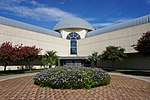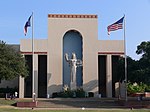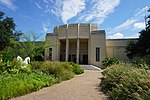Big Tex

Big Tex is a 55-foot (17 m) tall figure and marketing icon of the annual State Fair of Texas held at Fair Park in Dallas, Texas. The figure has become a cultural icon of Dallas and Texas. Since 1952 Big Tex has served as a cultural ambassador to visitors, and the figures prime location in the fairgrounds serves as a traditional meeting point. On October 19, 2012, the last weekend of the 2012 State Fair of Texas, Big Tex was destroyed by an electrical fire that started in the right boot and worked its way up the structure, first becoming visible from the neck area. After the fire, a new Big Tex was created by SRO Associates and Texas Scenic Co. This rendition made its first public appearance on September 26, 2013.Big Tex donned a mask in September 2020 while the fair was on hiatus because of the COVID-19 pandemic.
Excerpt from the Wikipedia article Big Tex (License: CC BY-SA 3.0, Authors, Images).Big Tex
South 2nd Avenue, Dallas
Geographical coordinates (GPS) Address Nearby Places Show on map
Geographical coordinates (GPS)
| Latitude | Longitude |
|---|---|
| N 32.7797 ° | E -96.7644 ° |
Address
African American Museum
South 2nd Avenue
75226 Dallas
Texas, United States
Open on Google Maps







